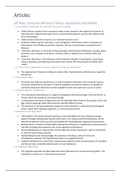Summary
Summary mandatory articles 1ZV20
- Course
- Institution
Summary for mandatory articles 1ZV20. Includes a summary of the following articles: • Jeff Bray: Consumer Behaviour Theory: Approaches and Models • Bloch, Peter H. and Marsha L. Richins (1983), “A theoretical model for the study of product importance perceptions,” Journal of Marketing, 47, ...
[Show more]



